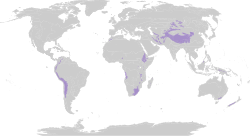
Montane grasslands and shrublands are a biome defined by the World Wildlife Fund. The biome includes high elevation grasslands and shrublands around the world. The term "montane" in the name of the biome refers to "high elevation", rather than the ecological term that denotes the region below the treeline.
This biome includes high elevation (montane and alpine) grasslands and shrublands, including the puna and páramo in South America, subalpine heath in New Guinea and East Africa, steppes of the Tibetan plateaus, as well as other similar subalpine habitats around the world.
The plants and animals of tropical montane páramos display striking adaptations to cool, wet conditions and intense sunlight. Around the world, characteristic plants of these habitats display features such as rosette structures, waxy surfaces, and abundant pilosity.
The páramos of the northern Andes are the most extensive examples of this habitat type. Although ecoregion biotas are most diverse in the Andes, these ecosystems are distinctive wherever they occur in the tropics. The heathlands and moorlands of East Africa (e.g., Mount Kilimanjaro, Mount Kenya, Rwenzori Mountains), Mount Kinabalu of Borneo, and the Central Range of New Guinea are all limited in extent, isolated, and support endemic plants and animals.
Drier subtropical montane grasslands, savannas, and woodlands include the Ethiopian Highlands, the Zambezian montane grasslands and woodlands, and the montane habitats of southeastern Africa.
The montane grasslands of the Tibetan Plateau still support relatively intact migrations of Tibetan antelope (Pantholops Hodgsoni) and kiang, or Tibetan wild ass (Equus hemionus). A unique feature of many tropical páramos is the presence of giant rosette plants from a variety of plant families, such as Lobelia (Africa), Puya (South America), Cyathea (New Guinea), and Argyroxiphium (Hawai’i). These plant forms can reach elevations of 4,500–4,600 metres (14,800–15,100 ft) above sea level.
Montane grassland and shrubland ecoregions
| Indomalayan montane grasslands and shrublands ecoregions | |
|---|---|
| Kinabalu montane alpine meadows | Malaysia |
See also
- Montane ecosystems – Ecosystems found in mountains
- Steppe – Ecoregion of plain grasslands without trees
References
- ^
 This article incorporates text available under the CC BY-SA 3.0 license. World Wide Fund for Nature. "Montane Grasslands and Shrubland Ecoregions". Archived from the original on 2011-04-01. Retrieved 2019-05-29.
This article incorporates text available under the CC BY-SA 3.0 license. World Wide Fund for Nature. "Montane Grasslands and Shrubland Ecoregions". Archived from the original on 2011-04-01. Retrieved 2019-05-29.
- Werger, MJA; van Bruggen, AC, eds. (1978). Biogeography and ecology of southern Africa. Springer. ISBN 9789061930839.
- White, F (1983). The vegetation of Africa: A descriptive memoir to accompany the UNESCO/AETFAT/UNSO vegetation map of Africa. Natural Resources Research. Vol. 20. Paris, France: UNESCO.
External links
 Media related to Montane grasslands and shrublands at Wikimedia Commons
Media related to Montane grasslands and shrublands at Wikimedia Commons
| Biogeographic regionalisations | |||||||||||||||||
|---|---|---|---|---|---|---|---|---|---|---|---|---|---|---|---|---|---|
| Biomes |
| ||||||||||||||||
| Biogeographic realms |
| ||||||||||||||||
| See also | |||||||||||||||||